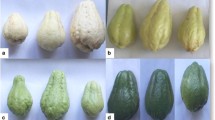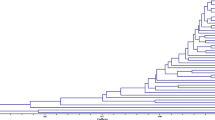Abstract
Key message
The study has unraveled the genetic relationship of under-utilised citrus varieties with rough lemons and found new insights into the development of suitable rootstocks for promoting citriculture in North-East India.
Abstract
Citrus resources of North-East India represent an invaluable source of various agronomic traits to breed new cultivars and rootstocks having adaptability to the agro-climatic conditions of the region. Lack of scientific approaches and resources towards identification and conservation of unique varieties of Citrus, destruction of natural habitats and absence of adequate information on the genetic relationship of existing citrus forms have resulted in the decline of citrus diversity in NE India. A total of 18 citrus genotypes of rough lemon strains and other under-utilized Citrus spp. collected from the region have been characterised using 22 SSR and 29 RAPD markers. The markers grouped the citrus genotypes into clusters of rough lemon, an acidic citrus group of lemon or natural hybrids and a small cluster of three genotypes. Polymorphic information content values of the SSR markers ranged from 0.481 to 0.90 and 0.26 to 0.45 in the case of RAPD markers. Similarity coefficient value ranged from 0.504 to 0.855 in RAPD while it varied from 0.299 to 0.723 in the case of SSR. C. assamensis along with two other Citrus genotypes grouped with a rough lemon cluster in SSR while shows genetic affinity with the acidic citrus group in RAPD analysis. Citrus indica was observed to be genetically distant from other citrus groups in both the marker systems studied. Grouping of related citrus forms and study of their genetic relationship will be of immense value for conservation and utilization of the region’s rich citrus resources.






Similar content being viewed by others
References
Allario T, Brumos J, Colmenero-Flores JM, Tadeo F, Froelicher Y, Talon M, Navarro L, Ollitrault P, Morillon R (2011) Large changes in anatomy and physiology between diploid Rangpur lime (Citrus limonia) and its autotetraploid are not associated with large changes in leaf gene expression. J Exp Bot 62:2507–2519
Allario T, Brumos J, Colmenero-Flores JM, Iglesias DJ, Pina JA, Navarro L (2013) Tetraploid Rangpur lime rootstock increases drought tolerance via enhanced constitutive root abscisic acid production. Plant Cell Environ 36:856–868
Arbona V, Gómez-Cadenas A (2008) Hormonal modulation of citrus responses to flooding. J Plant Growth Regul 27:241–250
Barkley NA, Roose ML, Krueger RR, Federici CT (2006) Assessing genetic diversity and population structure in a Citrus germplasm collection utilizing simple sequence repeat markers (SSRs). Theor Appl Genet 112:1519–1531
Bhattacharya SC, Dutta S (1956) Classification of Citrus fruits of Assam, Sc. Monogr. 20. ICAR, New Delhi, p 110
Carpena-Artes O, Moreno JJ, Lucena JJ, Carpena-Ruiz RO (1995) Response to iron chlorosis of different hydroponically grown citrus varieties. Springer, Dordrecht, pp 147–151
Castle WS (1987) Citrus rootstocks. In: Rom RC, Carlson RF (eds) Rootstocks for fruit crops. Wiley, New York, pp 361–399
Corazza-Nunes MJ, Machado MA, Nunes WMC, Cristofani M, Targon MLPN. (2002) Assessment of genetic variability in grapefruits (Citrus paradise Macf.) and pummelos (C. maxima (Burm.) Merr.) using RAPD and SSR markers. Euphytica 126:169–176
Das A, Sarkar J, Mondal B, Chaudhury S (2004) Genetic diversity analysis of citrus cultivars and rootstocks of Northeastern India by RAPD markers. Indian J Genet 64(4):281–285
Doyle JJ, Doyle JL (1990) A rapid total DNA preparation procedure for fresh plant tissue. Focus 12:13–15
Fang DQ, Roose ML, Krueger RR, Federici CT (1977) Fingerprinting trifoliate orange germ plasm accessions with isoenzymes, RFLPs, and inter-simple sequence repeat markers. Theor Appl Genet 95:211–219
Federici CT, Fang DQ, Scora RW, Roose ML (1998) Phylogenetic relationship within the genus Citrus (Rutaceae) and related genera as revealed by RFLP and RAPD analysis. Theory Appl Genet 96:812–822
Ferguson JJ, Garnsey SM (1993) Citrus virus and viruses-like diseases. Univ. of Florida, Florida Coop. Ext. Serv. Circ. 1131
Garcia-Lor A, Luro F, Navarro L, Ollitrault P (2012) Comparative use of InDel and SSR markers in deciphering the interspecific structure of cultivated citrus genetic diversity: a perspective for genetic association studies. Mol Genet Genom 287(1):77–94
Ghosh SP (1977) Citrus industry of north east India. Punjab Hort J 17:13–21
Gjamovski V, Kiprijanovski M (2011) Influence of nine dwarfing apple rootstocks on vigour and productivity of apple cultivar “Granny Smith”. Sci Hortic 129:742–746
Golein B, Bigonah M, Azadvar M, Golmohammadi M (2012) Analysis of genetic relationship between ‘Bakraee’ (Citrus sp.) and some known citrus genotypes through SSR and PCR-RFLP markers. Sci Hortic 148:147–153
Grosser JW, Ollitrault P, Olivares-Fuster O (2000) Somatic hybridization in citrus: an effective tool to facilitate variety improvement. In Vitro Cell Dev Biol Plant 36:434–449
Grosser JW, Graham JH, McCoy CW, Hoyte A, Rubio HM, Bright DB, Chandler JL (2003) Development of “tetrazyg” rootstocks tolerant of the diaprepes/phytophthora complex under greenhouse conditions. Proc Fla State Hortic Soc 116:262–267
Gulsen O, Roose ML (2001) Lemons: diversity and relationships with selected Citrus genotypes as measured with nuclear genome markers. J Am Soc Hortic Sci 126:309–317
Handa T, Ishizawa Y, Oogaki C (1986) Phylogenetic study of Fraction I protein in the genus Citrus and its close related genera. Jpn J Genet 61:15–24
Hardy S, Barkley P, Creek A, Donovan N (2012) Impacts and management of flooding and waterlogging in citrus orchards. NSW Government, (Primefact 1189). http://www.industry.nsw.gov.au/publications. Accessed 2 June 2017
Hazarika TK (2012) Citrus genetic diversity of north-east India, their distribution, ecogeography and ecobiology. Genet Resour Crop Evol 59:1267–1280
Hussain S, Curk F, Dhuique-Mayer C, Urban L, Ollitrault P, Luro F, Morillon R (2012) Autotetraploid trifoliate orange (Poncirus trifoliata) rootstocks do not impact clementine quality but reduce fruit yields and highly modify rootstock/scion physiology. Sci Hortic 134:100–107
Jena SN, Kumar S, Nair NK (2009) Molecular phylogeny in Indian Citrus L. (Rutaceae) inferred through PCR-RFLP and trnL-trnF sequence data on chloroplast DNA. Sci Hortic 119:403–416
Kijas JMH, Fowler JCS, Thomas MR (1995) An evaluation of sequence-tagged microsatellite-site markers for genetic analysis within Citrus and related species. Genome 38:349–355
Kumar S, Nair KN, Jena SN (2013) Molecular differentiation in Indian Citrus L. (Rutaceae) inferred from nrDNA ITS sequence analysis. Genet Resour Crop Evol 60:59–75
Mabberley DJ (2004) Citrus (Rutaceae): a review of recent advances in etymology, systematics and medical applications. Blumea 49:481–498
Malik MN, Scora RW, Soost RK (1974) Studies on the origin of lemon. Hilgardia 42:361–382
Marak C, Laskar MA (2010) Analysis of phonetic relationship between Citrus indica Tanaka and a few commercially important Citrus species by ISSR marker. Sci Hortic 124:345–348
Nair KN, Nayar MP (1997) Rutaceae. In: Hajra PK, Nair VJ, Daniel P (eds) Flora of India, vol IV. Botanical Survey of India, Calcutta, pp 229–407
Nicolosi E, Deng ZN, Gentile A, Malfa SL, Ciotinella G, Tribulato E (2000) Citrus phylogeny and genetic origin of important species as investigated by molecular markers. Theor Appl Genet 100:1155–1166
Pandey A, Tomer AK, Bhandri DC, Pareek SK (2008) Towards collection of wild relatives of crop plants in India. Genet Resour Crop Evol 55(2):187–202
Rao MN, Soneji JR, Chen C, Huang S, Gmitter FG (2008) Characterisation of zygotic and nucellar seedlings from sour orange-like citrus rootstock candidates using RAPD and EST-SSR markers. Tree Genet Genomes 4(1):113–124
Rohlf FJ (2005) NTSYSpc numerical taxonomy and multivariate analysis system. Version 2.2. Exeter Software, New York
Saleh B, Allario T, Dambier D, Ollitrault, Morillon R (2008) Tetraploid citrus rootstocks are more tolerant to salt stress than diploid. Comptes Rendus Biol 331:703–710
Schäfer G, Bastianel M, Dornelles ALC (2001) Porta-enxertos utilizados na citricultura. Ciê Rural Santa Maria 31(4):723–733
Sharma BD, Hore DK, Gupta SK (2004) Genetic resources of Citrus of north-eastern India and their potential use. Genet Resour Crop Evol 51:411–418
Siragusa M, De Pasquale F, Abbate L, Tusa N (2006) Identification of sour orange accessions and evaluation of their genetic variability by molecular marker analyses. Hortic Sci 41(1):84–89
Sneath PHA, Sokal RR (1973) Numerical taxonomy. Freeman, San Francisco
Soost R, Cameron J, Janick J, Moore J (1975) Advances in fruit breeding. Purdue University Press, West Lafayette
Swingle WT (1943) The botany of Citrus and its relatives of the orange subfamily Aurantioidae of the family Rutaceae. In: Webber HJ, Batcheler LD (eds) The Citrus industry, vol 1. University of California, Berkley, pp 129–474
Swingle WT, Reece PC (1967) The botany of Citrus and its wild relatives. In: Reuther W, Webber HJ, Batchelor LD (eds) The Citrus industry, vol 1. University of California, Berkeley, pp 190–430
Syvertsen JP (1981) Hydraulic conductivity of four commercial citrus rootstocks. J Am Soc Hort Sci 106:378–381
Syvertsen JP, Lloyd J (1994) Citrus. In: Schaffer B, Andersen PC (eds) Handbook of environmental physiology of fruit crops, vol. 2. CRC Press, Boca Raton, pp 65–99
Tanaka T (1928) On certain new species of Citrus. Stud Citrol 2:155–164
Tanaka T (1977) Fundamental discussion of Citrus classification. Stud Citrol 14:1–6
Tworkoski T, Miller S (2007) Rootstock effect on the growth of apple scions with different growth habits. Sci Hortic 111:335–343
Vu JCV, Yelenosky G (1987) Photosynthetic characteristics in leaves of ‘Valencia’ orange (Citrus sinensis (L.) Osbeck) grown under high and low temperature regimes. Environ Exp Bot 27:279–287
Yu Q, Chen C, Du D, Huang M, Yao J, Yu F, Brlansky RH, Gimitter FG (2017) Reprogramming of a defense signaling pathway in rough lemon and sweet orange is a critical element of the early response to ‘Candidatus Liberibacter asiaticus’. Hortic Res (4):17063. https://doi.org/10.1038/hortres.2017.63
Acknowledgements
The authors are thankful to the Director, Institute of Bioresources and Sustainable Development, Takyelpat, Imphal for providing research facilities. The assistance rendered by Mr. K.Sanjit Singh, Lab Attendant, PTC Lab, IBSD is gratefully acknowledged.
Author information
Authors and Affiliations
Corresponding author
Ethics declarations
Conflict of interest
The authors declare that they have no conflict of interests. The authors alone are responsible for the content and writing of the paper.
Additional information
Communicated by L. Kalcsits.
Rights and permissions
About this article
Cite this article
Sanabam, R., Singh, N.S., Sahoo, D. et al. Genetic relationship of rough lemon landraces and under-utilised citrus genotypes from North-East India revealed by SSR and RAPD markers. Trees 32, 1043–1059 (2018). https://doi.org/10.1007/s00468-018-1694-z
Received:
Accepted:
Published:
Issue Date:
DOI: https://doi.org/10.1007/s00468-018-1694-z




